Content for TS 23.502 Word version: 18.5.0
1…
4.2.2.2.2
4.2.2.2.3…
4.2.2.3…
4.2.3…
4.2.3.3
4.2.4…
4.2.6
4.2.7…
4.2.9…
4.2.11…
4.2.11.5…
4.3…
4.3.2.2.2
4.3.2.2.3…
4.3.3…
4.3.3.3
4.3.4…
4.3.4.3
4.3.5…
4.3.5.2…
4.3.5.4…
4.3.5.6…
4.3.6…
4.4…
4.5…
4.9…
4.9.1.3…
4.9.2…
4.11…
4.11.1…
4.11.1.2.2
4.11.1.2.3
4.11.1.3…
4.11.1.3.3…
4.11.1.4…
4.11.1.5…
4.11.2…
4.11.3…
4.12…
4.12.6…
4.12a…
4.12b…
4.13…
4.13.4…
4.13.6…
4.14…
4.15…
4.15.3.2.5…
4.15.4…
4.15.6…
4.15.6.7…
4.15.6.13…
4.15.6.14…
4.15.9…
4.15.9.4…
4.15.13…
4.15.13.4…
4.16…
4.16.4…
4.16.8…
4.16.11…
4.16.14…
4.16.15…
4.17…
4.17.9…
4.18…
4.19…
4.22…
4.23…
4.23.7…
4.23.7.3.3
4.23.7.3.4…
4.23.9…
4.23.9.4…
4.23.11…
4.24…
4.25…
4.25.6…
4.26…
5…
5.2.3…
5.2.5…
5.2.6…
5.2.7…
5.2.8…
5.2.9…
5.2.12…
5.2.18…
A…
E…
F…
G
H…
4.2.11 Network Slice Admission Control Function (NSACF) procedures
4.2.11.1 General
4.2.11.2 Number of UEs per network slice availability check and update procedure
4.2.11.2a Hierarchical NSACF-based number of UEs per network slice availability check and update procedure
4.2.11.3 Configuration for Early Admission Control (EAC) update procedure
4.2.11.4 Number of PDU Sessions per network slice availability check and update procedure
4.2.11.4a Hierarchical NSACF-based Number of PDU Sessions per network slice availability check and update procedure
...
...
4.2.11 Network Slice Admission Control Function (NSACF) procedures |R17| p. 108
4.2.11.1 General p. 108
The Network Slice Admission Control Function procedures are performed for an S-NSSAI which is subject to Network Slice Admission Control (NSAC) as described in TS 23.501. If charging needs to be enabled, the NSACF may act as a NF (CTF) and interact with the CHF to support the Event based charging as defined in TS 32.290.
Depending on the NSAC architecture deployed in the network, three options of NSAC procedures are defined:
- Option 1: The NSAC procedure for number of UEs or PDU sessions for an S-NSSAI is based on non-Hierarchal NSAC architecture. The corresponding procedures are described in clause 4.2.11.2 and clause 4.2.11.4 respectively.
- Option 2: The NSAC procedure for number of UEs or PDU sessions for an S-NSSAI is based on centralized NSAC architecture. The corresponding procedures are described in clause 4.2.11.2 and clause 4.2.11.4 respectively.
- Option 3: The NSAC procedure for number of UEs or PDU sessions for an S-NSSAI is based on hierarchical NSAC architecture. The corresponding procedures are described in clause 4.2.11.2a and clause 4.2.11.4a respectively.
4.2.11.2 Number of UEs per network slice availability check and update procedure p. 108
This clause applies to Non-Hierarchical and centralized NSAC architectures. The difference between the two architectures for the various steps, where applicable, is described at the end of the clause.
The number of UEs per network slice availability check and update procedure is to update (i.e. increase or decrease) the number of UEs registered with an S-NSSAI which is subject to NSAC. The AMF is configured with the information indicating which network slice is subject to NSAC.
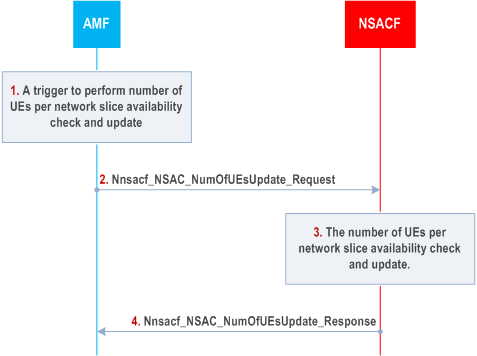
Step 1.
For a centralized architecture the following differences apply:
If the AMF is not aware of which NSACF to communicate, the AMF performs NSACF discovery as described in clause 6.3.22 of TS 23.501 and in clause 5.2.7.3.2. The AMF triggers the Number of UEs per network slice availability check and update procedure to update the number of UEs registered with a network slice when a network slice subject to NSAC is included in the Allowed NSSAI or Partially Allowed NSSAI (i.e. the AMF requests to register the UE with the S-NSSAI) or removed from the Allowed NSSAI or Partially Allowed NSSAI (i.e. the AMF requests to de-register the UE from the S-NSSAI) for a UE. The trigger event at the AMF also includes the change of Allowed NSSAI or Partially Allowed NSSAI in the case of inter-AMF mobility. The procedure is triggered in the following cases:
Step 2.
-
At UE Registration procedure, according to clause 4.2.2.2.2 (including Registration types of Initial Registration or Mobility Registration Update in inter-AMF mobility in CM-CONNECTED or CM-IDLE state):
- before the Registration Accept in step 21 if the EAC mode is active; or
- after the Registration Accept message if the EAC mode is not active;
- At UE Deregistration procedure, as per clause 4.2.2.3, after the Deregistration procedure is completed;
-
At UE Configuration Update procedure (which may result from NSSAA procedure or subscribed S-NSSAI change):
- before the UE Configuration Update message if the EAC mode is active and the update flag is to increase; or
- after the UE Configuration Update message if the EAC mode is active and the update flag is to decrease; or
- after the UE Configuration Update message if the EAC mode is not active.
The AMF sends Nnsacf_NSAC_NumOfUEsUpdate_Request message to the NSACF. The AMF includes in the message the UE ID, Access Type to which the Allowed NSSAI or Partially Allowed NSSAI is applied, the S-NSSAI(s), the NF ID and the update flag which indicates whether the number of UEs registered with the S-NSSAI(s) is to be increased when the UE has gained registration to network slice(s) subject to NSAC or the number of UEs registered with the S-NSSAI(s) is to be decreased when the UE has deregistered from S-NSSAI(s) or could not renew its registration to an S-NSSAI subject to NSAC.
If this is the first time to perform NSAC procedure for the S-NSSAI towards the NSACF, the AMF includes notification endpoint for EAC Notification to implicitly subscribe the EAC notification for the S-NSSAI from the NSACF.
Step 3.
The NSACF determines whether the Access Type provided by the AMF is configured for the NSAC based on its configuration. If the Access Type is not configured for the NSAC, the NSACF always accepts the request from the AMF without increasing or decreasing the number of UEs. If the Access Type is configured for the NSAC, the NSACF updates the current number of UEs registered for the S-NSSAI, i.e. increases or decrease the number of UEs registered per network slice based on the information provided by the AMF in the update flag parameter.
If the update flag parameter from the AMF indicates increase, the following applies:
Step 4.
- If the UE ID is already in the list of UEs registered with the network slice, the current number of UEs is not increased as the UE has already been counted as registered with the network slice. The NSACF creates a new entry associated with this new update and shall also maintain the old entry associated with previous update. The multiple entries for the same UE ID in the NSACF are differentiated based on the NF ID of the NF sending the update request. The NSACF removes the entry associated with the NF ID upon reception of a request having update flag indicating decrease.
- If the UE ID is not in the list of UE IDs registered with the network slice and the maximum number of UEs registered with the network slice has not been reached yet, the NSACF adds the UE ID in the list of UEs registered with the network slice as a new entry associated with this new update and increases the current number of the UEs registered with the network slice. If the UE ID is not in the list of UEs registered with that S-NSSAI and the maximum number of UEs for that S-NSSAI has already been reached, then the NSACF returns a result parameter indicating that the maximum number of UEs registered with the network slice has been reached.
The NSACF returns the Nnsacf_NSAC_NumOfUEsUpdate_Response message including Result indication per S-NSSAI. The Result indication includes either 'maximum number of UEs registered with the network slice reached' or 'maximum number of UEs registered with the network slice not reached'.
At UE Registration procedure, if only some of the S-NSSAIs reached the maximum number of UEs per S-NSSAI, the AMF sends a Registration Accept message to the UE in which the AMF includes the rejected S-NSSAI(s) in the rejected NSSAI list for which the NSACF has indicated that the maximum number of UEs per network slice has been reached and for each rejected S-NSSAI the AMF includes a reject cause set to 'maximum number of UEs per network slice reached' and optionally a back-off timer.
When for all the Requested S-NSSAI(s) provided in step 2 the NSACF returned the maximum number of UEs per network slice has been reached and if one or more subscribed S-NSSAIs are marked as default in the subscription data and not subject to NSAC, the AMF can decide to include these Default Subscribed S-NSSAIs in the Allowed NSSAI. Otherwise, the AMF rejects the UE request for registration. In the Registration Reject message, the AMF includes the rejected S-NSSAI(s) in the rejected NSSAI parameter and for each rejected S-NSSAI the AMF includes a reject cause to indicate that the maximum number of UEs per network slice has been reached and optionally a back-off timer.
-
In step 2, the AMF additionally includes the NSAC service area the AMF belongs to, if available, as an additional parameter in the Nnsacf_
NSAC_ .NumOfUEsUpdate_ Request - In step 3, based on operator configuration, the NSACF performs the validation against the maximum number of Registered UEs registered per NSAC service area defined for the network slice if applicable and available, or the maximum number of Registered UEs in the entire PLMN for the network slice. Additionally the NSACF stores the NSAC service area of AMF if available.
4.2.11.2a Hierarchical NSACF-based number of UEs per network slice availability check and update procedure |R18| p. 111
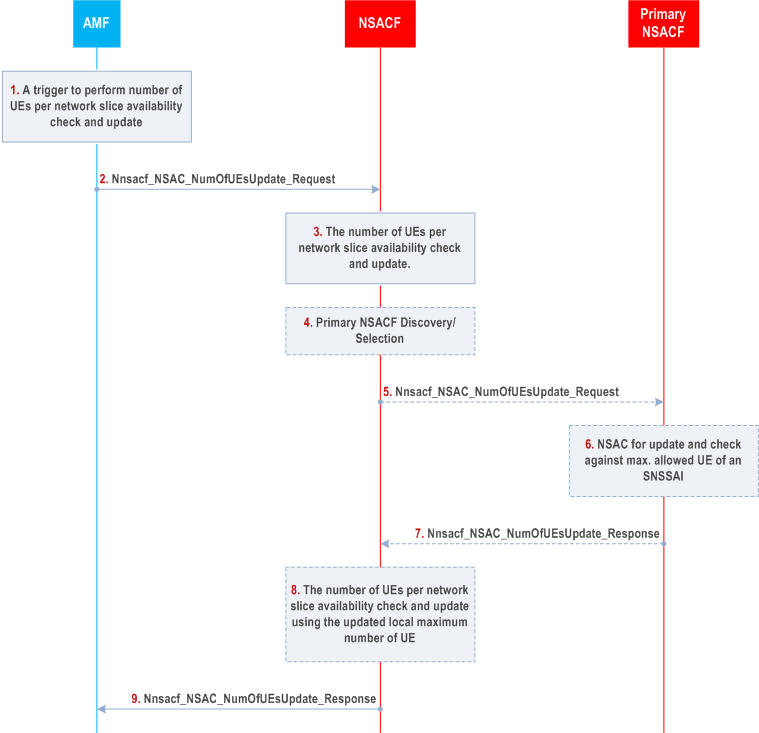
For an S-NSSAIs subject to counting of the number of registered UEs, if hierarchical NSACF architecture is deployed in the network the enforcement of maximum number of UEs registered for an S-NSSAI is performed as follows:
Step 1.
Same as the step 1 defined in clause 4.2.11.2.
Step 2.
In addition to the information included in the Nnsacf_NSAC_NumOfUEsUpdate_Request as described in the step 2 of clause 4.2.11.2, the AMF may provide UE already registered indication to the NSACF if the UE has been registered with the S-NSSAI in another NSAC service area before. The AMF determines the indication based on the received Allowed NSSAI information from the source AMF (in case of inter AMF handover) or from SMF+PGW-C (in case of mobility from EPS to 5GS).
Step 3.
The NSACF performs NSAC for the indicated S-NSSAI.
If the update flag parameter from the AMF indicates increase, the following applies:
Step 4.
-
For NSACF which support UE admission quota based control:
- If the local maximum number of UEs is not reached yet, the NSACF executes the same action as specified in the step 3 in clause 4.2.11.2. The steps 4-8 are skipped.
- If the local maximum number of UEs is reached, the NSACF sends a delegation request to the Primary NSACF. Steps 4-9 are executed.
-
For NSACF which supports UE admission threshold-based control, as defined in clause 5.15.11.1.2 of TS 23.501:
- If the UE admission is below the threshold level, the NSACF executes the same action as the step 3 defined in clause 4.2.11.2. Steps 4-8 are skipped.
- If the UE admission is at or above the threshold level and the local maximum number of UEs has not been reached, the NSACF checks whether the UE already registered indication is present.
- If the UE already registered indication is not present then the NSACF immediately rejects the NSAC request. Steps 4-8 are skipped.
- If the UE already registered indication is present the NSACF executes the same action as the step 3 defined in clause 4.2.11.2 in order to allow for service continuity. Steps 4-8 are skipped.
- If the local maximum number has been reached and the UE already registered indication is present then the NSACF sends a delegation request of NSAC to the Primary NSACF in order to allow for service continuity. Steps 4-9 are executed.
- If the UE entry to be deleted is stored at the NSACF, the NSACF executes the same action as the step 3 defined in clause 4.2.11.2. Steps 4-8 are skipped.
- If the UE entry to be deleted is not stored at the NSACF, the NSACF sends a delegation request of NSAC to the Primary NSACF. Steps 4-9 are executed.
If the Primary NSACF has not been discovered before, the NSACF discovers and selects the Primary NSACF which manages the entire PLMN NSAC service area according to clause 6.3.22 of TS 23.501.
Step 5.
The NSACF invokes Nnsacf_NSAC_NumOfUEsUpdate_Request service operation to the Primary NSACF. The request includes the NSAC request information received from AMF, which may include the UE already Registered indication only if it is received from AMF and the UE admission type is quota-based.
Step 6.
The Primary NSACF performs NSAC for the indicated S-NSSAI.
If the update flag parameter from the NSACF indicates increase, the following applies:
Step 7.
- If the Primary NSACF decided to delegate the NSAC update request to the NSACF, per the applied UE admission type of the network, the Primary NSACF adjusts the local maximum number for UE quota-based admission or the UE admission threshold for UE admission-threshold in its response to the NSACF. The Primary NSACF does not create a new entry associated with the UE ID in the received NSAC request.
- For quota-based admission type and if the Primary NSACF decided not to delegate the request to the NSACF and the UE already Registered indication is not included, the Primary NSACF rejects the NSAC request. If the UE already Registered indication is included and if the Primary NSACF decided to store the UE entry, it creates a new entry associated with the UE ID within the received NSAC. If the Primary NSACF is not able to store the UE entry, the Primary NSACF rejects the request. The Primary NSACF respond accordingly the NSACF as in step 7.
- For threshold-based admission and if the Primary NSACF decided not to delegate the request to the NSACF, the same action as for step 3 in clause 4.2.11.2 is executed with the replacement of NSACF with Primary NSACF.
The Primary NSACF returns the Nnsacf_NSAC_NumOfUEsUpdate_Response message to the NSACF. The response may include the Result indication as described in step 4 in clause 4.2.11.2.
If the Primary NSACF determines to adjust the configured value stored at the NSACF, the updated local maximum number of UEs or UE admission threshold is also included in the response respectively.
Step 8.
The NSACF checks the response from Primary NSACF.
If the response includes the updated configured value,
Step 9.
- The NSACF, which supports UE admission quota based control, replaces the existing local maximum number of UEs with the received updated value. The same action is executed as for step 3 in clause 4.2.11.2 based on the updated configured value.
- The NSACF, which supports UE admission threshold based control, replaces the existing UE admission threshold with the received updated value. The same action is executed as for step 3 in clause 4.2.11.2 based on the updated configured value.
Same as for step 4 defined in clause 4.2.11.2.
4.2.11.3 Configuration for Early Admission Control (EAC) update procedure p. 113
The configuration for Early Admission Control (EAC) update procedure indicates to the AMF the activation or the deactivation of the EAC mode for the S-NSSAI subject to NSAC. EAC mode means that the AMF is required to perform the number of UEs per network slice availability check and update procedure before the S-NSSAI subject to NSAC is included in the Allowed NSSAI or Partially Allowed NSSAI and sent to the UE. EAC mode is only applicable in the AMF when the update flag is set to increase.
The AMF implicitly subscribes to the EAC notification for the S-NSSAI when it performs the first network slice availability check and update procedure for the S-NSSAI with the NSACF. The NSACF sends the EAC mode notification towards all notification endpoints associated with the S-NSSAI.
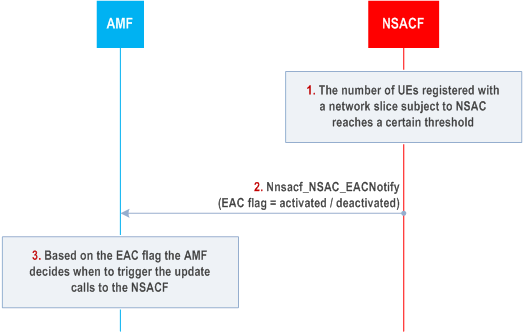
Step 1.
If the EAC flag indicates EAC mode activated, the AMF triggers the number of UEs per network slice availability check and update procedure before the Registration Accept step of the registration procedure or before the UE Configuration Update message.
If the EAC flag indicates EAC mode deactivated, the AMF triggers the number of UEs per network slice availability check and update procedure after Registration Accept step of the registration procedure or after the UE Configuration Update.
The number of UEs registered with a network slice subject to NSAC crosses a certain operator defined threshold. The NSACF determines whether to activate or deactivate the EAC mode.
Step 2.
The NSACF triggers Nnsacf_NSAC_EACNotify operation including the S-NSSAI(s) for which the EAC mode is to be activated or deactivated and a EAC flag(s) set to activated if the number of UEs registered with the network slice is above certain threshold or set to deactivated if the number of the UEs registered with the network slice is below certain threshold which may be same or different with respect to the activation threshold.
Step 3.
The AMF uses the EAC flag to decide when to trigger the number of UEs per network slice availability check and update procedure so that delays to the registration procedure and impact to the already allowed network slices are avoided.
4.2.11.4 Number of PDU Sessions per network slice availability check and update procedure p. 114
This clause applies to Non-Hierarchical NSAC and centralized NSAC architectures. The difference between the two architectures for the various steps, where applicable, is described at the end of the clause.
The number of PDU Sessions per network slice availability check and update procedure is to update (i.e. increase or decrease) the number of PDU Sessions established on S-NSSAI which is subject to NSAC. The SMF is configured with the information indicating which network slice is subject to NSAC.
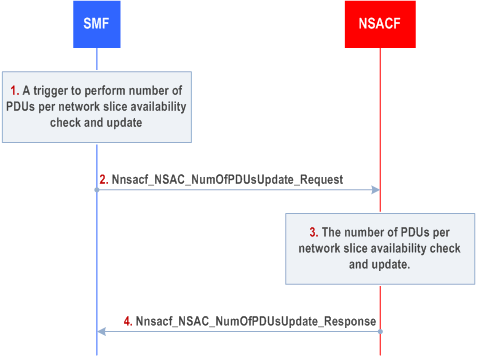
Step 1.
For a centralized architecture the following differences apply:
If the SMF is not aware of which NSACF to communicate, the SMF performs NSACF discovery as described in clause 6.3.22 of TS 23.501 and in clause 5.2.7.3.2. The SMF anchoring the PDU session triggers the Number of PDU Sessions per network slice availability check and update procedure for the network slices that are subject to NSAC at the beginning of a PDU Session Establishment procedure (clause 4.3.2.2.1 and clause 4.3.2.2.2) only for new PDU Sessions to be established and as a last step of successful PDU Session Release procedure (clause 4.3.4.2 and clause 4.3.4.3).
Step 2.
The SMF anchoring the PDU session sends Nnsacf_NSAC_NumOfPDUsUpdate_Request message to the NSACF. The SMF includes in the message the UE-ID, the PDU session ID, S-NSSAI for which the number of PDU Sessions per network slice update is required, Access Type and the update flag. The update flag may include one of the following values:
Step 3.
- 'increase' which indicates that the number of PDUs established on the S-NSSAI is to be increased when the procedure is triggered at the beginning of PDU Session Establishment procedure or when a new user plane leg is to be established for an MA-PDU Session;
- 'decrease' which indicates that the number of PDU Sessions on the S-NSSAI is to be decreased when the procedure is triggered at the end of PDU Sessions Release procedure or when an existing user plane leg is to be released for an MA PDU Session. In the case of a PDU Session Establishment failure, the anchor SMF triggers another request to the NSACF with the update flag parameter equal to decrease in order to re-adjust back the PDU Session counter in the NSACF; or
- 'update' which indicates that for existing PDU Session the Access Type is to be replaced with a new Access Type during inter access mobility.
The NSACF updates the current number of PDU Sessions established on the S-NSSAI, i.e. increase or decrease the number of PDU Sessions per network slice based on the information provided by the anchor SMF in the update flag parameter.
If the update flag parameter from the SMF anchoring the PDU session indicates increase value and the maximum number of PDU Sessions established on the S-NSSAI has already been reached, then the NSACF returns a result parameter indicating that the maximum number of PDU Sessions per network slice has been reached. If the maximum number of PDU Sessions established on the S-NSSAI has not been reached, the NSACF checks the UE ID. If the UE ID is located, the NSACF, stores the PDU Session ID and the Access Type and increases the number of PDU Sessions for that S-NSSAI. If the NSACF did not locate the UE ID, it creates an entry for the UE ID, stores the PDU Session ID and Access Type and increases the number of PDU Sessions for that S-NSSAI.
If the update flag parameter from the SMF anchoring the PDU session indicates decrease value, the current number of PDU Sessions per S-NSSAI, the NSACF locates the UE ID and decreases the number of PDU Sessions for that S-NSSAI and removes the related PDU Session ID entry. If the UE ID has no more PDU sessions, after the decrease, the NSACF removes the UE ID entry.
If the update flag parameter from the SMF anchoring the PDU session indicates update value, the NSACF locates the existing entry with UE ID and PDU Session ID and replaces the Access Type in the existing entry.
The NSACF takes the Access Type parameter into account for increasing and decreasing the number of PDU Sessions per S-NSSAI as described in clause 5.15.11.2 of TS 23.501. For MA-PDU Session, if the SMF received information that the UE is registered over both accesses, the SMF provides multiple Access Types to the NSACF. If the NSACF receives a request containing multiple Access Types, the NSACF provides a Result indication for each Access Type.
Step 4.
The NSACF acknowledges the update to the anchor SMF with Nnsacf_NSAC_NumOfPDUsUpdate_Response message including a Result indication. If the NSACF returns a Result indication including ' maximum number of PDU Sessions per S-NSSAI reached', the SMF rejects the PDU Session establishment request with reject cause set to 'maximum number of PDU Sessions per S-NSSAI reached' and optionally a back-off timer and the Access Type.
For MA PDU Session Establishment, the NSACF may accept the MA PDU Session and may provide to the SMF a Result indicating 'maximum number of PDU Sessions per S-NSSAI reached' or 'maximum number of PDU Sessions per S-NSSAI not reached' associated with an Access Type. If the NSACF indicates a failure that is associated with the Access Type over which the UE sent the MA PDU Session Establishment Request, the SMF sends to the UE a PDU Session Establishment Reject with a Result indication including 'maximum number of PDU Sessions per S-NSSAI reached' ,optionally a back-off timer and the Access Type. When the SMF rejects the MA PDU Session, the SMF sets the Access Type parameter as follows:
-
If the UE is registered via both accesses and:
- If the NSACF indicates failure for both accesses, the Access Type indicates both accesses;
- If the NSACF indicates failure for the access over which the MA-PDU Session Establishment Request is received, the Access Type indicates the access over which the MA-PDU Session Request is received.
- If the UE is registered via a single access, the Access Type indicates the access over which the MA-PDU Session Request is received.
- For MA PDU Session Release over single Access Type, the NSACF locates the existing entry with PDU Session ID and if founds the entry with both Access Type then it removes only the received Access Type entry while keeping the PDU Session ID.
-
In step 2, the SMF additionally includes the NSAC service area the SMF belongs to, if available, as an additional parameter in the Nnsacf_
NSAC_ .NumOfPDUsUpdate_ Request - In step 3, based on operator configuration, the NSACF performs the validation against the maximum number of PDU Sessions established on the S-NSSAI per NSAC service area, if applicable and available, or maximum number of PDU Sessions established on the S-NSSAI in the entire PLMN. Additionally the NSACF stores the NSAC service area of SMF if available.
4.2.11.4a Hierarchical NSACF-based Number of PDU Sessions per network slice availability check and update procedure |R18| p. 117
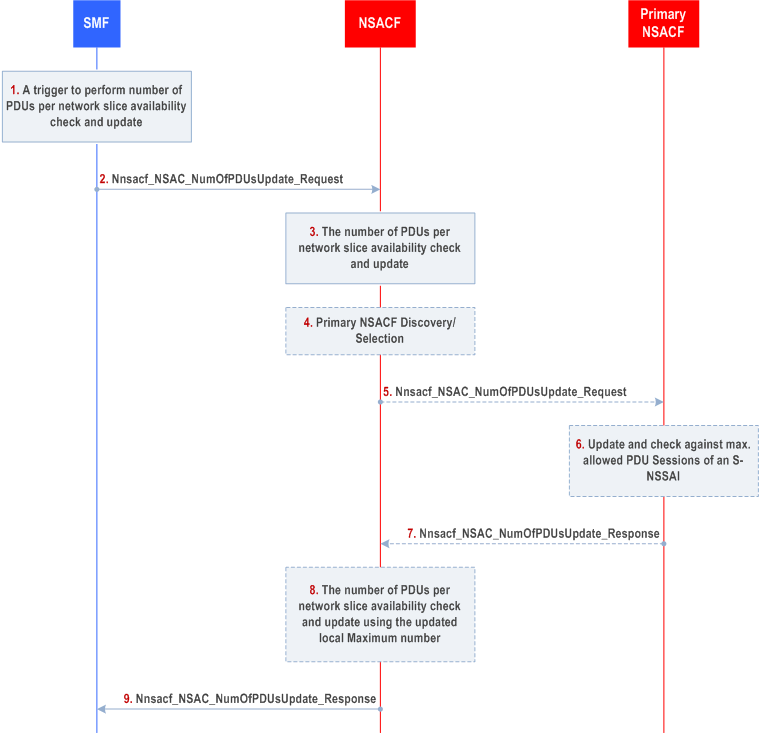
For an S-NSSAI subject to counting of the number of PDU sessions, if hierarchical NSACF architecture is deployed in the network the enforcement of maximum number of PDU Session established for an S-NSSAI is performed as follow:
Step 1-2.
Same as for steps 1-2 defined in clause 4.2.11.4.
Step 3.
The NSACF performs NSAC for the indicated S-NSSAI.
If the PDU session ID entry update at the NSACF is possible, e.g. create a new entry associated with the received NSAC request for increase case, the same action as for step 3 defined in clause 4.2.11.4 is executed. Steps 4-8 are skipped.
If the PDU session ID entry at the NSACF is not possible, i.e. by admitting the PDU session the local maximum PDU session number is exceeded, the NSACF delegates the request to the Primary NSACF for an updated local maximum PDU sessions from the Primary NSACF.
Step 4.
If the Primary NSACF has not been discovered before, the NSACF discovers and selects the Primary NSACF, which manages the global NSAC service area as for clause 6.3.22 of TS 23.501.
Step 5.
The NSACF invokes Nnsacf_NSAC_NumOfPDUsUpdate request to the Primary NSACF. The request message includes the S-NSSAI.
Step 6.
The Primary NSACF checks the global maximum PDU session number and determines whether to accept or reject the request to update local maximum PDU session number from NSACF.
Step 7.
The Primary NSACF returns the Nnsacf_NSAC_NumOfPDUsUpdate response. The response includes a new allocated local maximum PDU sessions number or an indication to reject the request to update local maximum PDU session number.
Step 8.
If the primary NSACF provides an updated local maximum number, the NSACF replaces the local maximum PDU session number with the received local maximum PDU sessions number value. The same action is executed as for step 3 in clause 4.2.11.4 based on the updated configured value.
Step 9.
Same as for step 4 of clause 4.2.11.4.